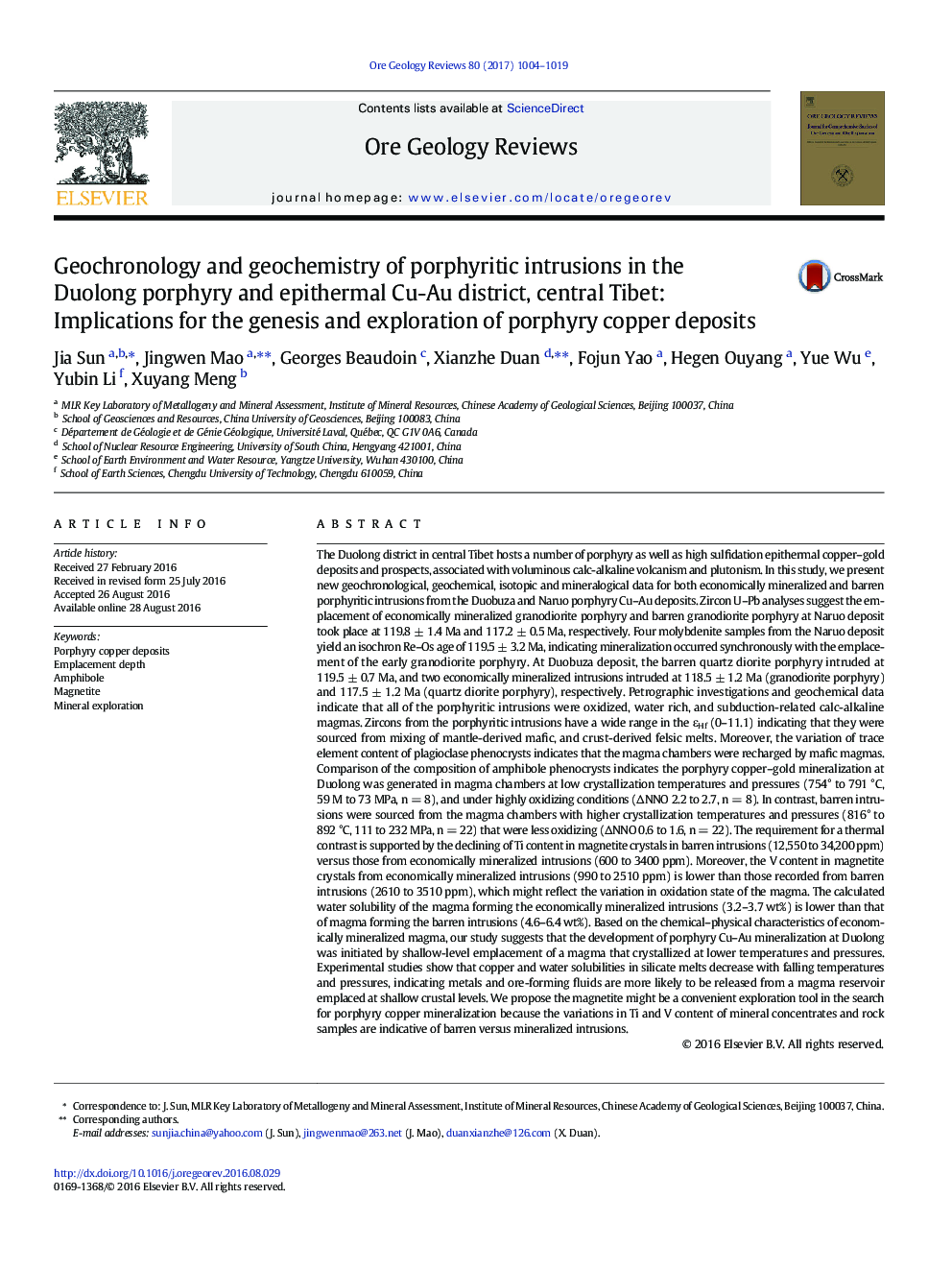| کد مقاله | کد نشریه | سال انتشار | مقاله انگلیسی | نسخه تمام متن |
|---|---|---|---|---|
| 6435679 | 1637226 | 2017 | 16 صفحه PDF | دانلود رایگان |

- The emplacement of porphyritic intrusions and Cu-Au mineralization took place within a short period (120Â ~Â 117 Ma) at Duolong.
- The generation of porphyritic intrusions was caused by a mixing of mantle-derived melts and crust-derived melts.
- The generation of copper-gold mineralization was related to magma chambers of lower crystallization temperatures and pressures.
- Magnetite might be a exploration tool due to the variation of Ti and V contents in the barren and mineralized intrusions.
The Duolong district in central Tibet hosts a number of porphyry as well as high sulfidation epithermal copper-gold deposits and prospects, associated with voluminous calc-alkaline volcanism and plutonism. In this study, we present new geochronological, geochemical, isotopic and mineralogical data for both economically mineralized and barren porphyritic intrusions from the Duobuza and Naruo porphyry Cu-Au deposits. Zircon U-Pb analyses suggest the emplacement of economically mineralized granodiorite porphyry and barren granodiorite porphyry at Naruo deposit took place at 119.8 ± 1.4 Ma and 117.2 ± 0.5 Ma, respectively. Four molybdenite samples from the Naruo deposit yield an isochron Re-Os age of 119.5 ± 3.2 Ma, indicating mineralization occurred synchronously with the emplacement of the early granodiorite porphyry. At Duobuza deposit, the barren quartz diorite porphyry intruded at 119.5 ± 0.7 Ma, and two economically mineralized intrusions intruded at 118.5 ± 1.2 Ma (granodiorite porphyry) and 117.5 ± 1.2 Ma (quartz diorite porphyry), respectively. Petrographic investigations and geochemical data indicate that all of the porphyritic intrusions were oxidized, water rich, and subduction-related calc-alkaline magmas. Zircons from the porphyritic intrusions have a wide range in the εHf (0-11.1) indicating that they were sourced from mixing of mantle-derived mafic, and crust-derived felsic melts. Moreover, the variation of trace element content of plagioclase phenocrysts indicates that the magma chambers were recharged by mafic magmas.Comparison of the composition of amphibole phenocrysts indicates the porphyry copper-gold mineralization at Duolong was generated in magma chambers at low crystallization temperatures and pressures (754° to 791 °C, 59 M to 73 MPa, n = 8), and under highly oxidizing conditions (ÎNNO 2.2 to 2.7, n = 8). In contrast, barren intrusions were sourced from the magma chambers with higher crystallization temperatures and pressures (816° to 892 °C, 111 to 232 MPa, n = 22) that were less oxidizing (ÎNNO 0.6 to 1.6, n = 22). The requirement for a thermal contrast is supported by the declining of Ti content in magnetite crystals in barren intrusions (12,550 to 34,200 ppm) versus those from economically mineralized intrusions (600 to 3400 ppm). Moreover, the V content in magnetite crystals from economically mineralized intrusions (990 to 2510 ppm) is lower than those recorded from barren intrusions (2610 to 3510 ppm), which might reflect the variation in oxidation state of the magma. The calculated water solubility of the magma forming the economically mineralized intrusions (3.2-3.7 wt%) is lower than that of magma forming the barren intrusions (4.6-6.4 wt%). Based on the chemical-physical characteristics of economically mineralized magma, our study suggests that the development of porphyry Cu-Au mineralization at Duolong was initiated by shallow-level emplacement of a magma that crystallized at lower temperatures and pressures. Experimental studies show that copper and water solubilities in silicate melts decrease with falling temperatures and pressures, indicating metals and ore-forming fluids are more likely to be released from a magma reservoir emplaced at shallow crustal levels. We propose the magnetite might be a convenient exploration tool in the search for porphyry copper mineralization because the variations in Ti and V content of mineral concentrates and rock samples are indicative of barren versus mineralized intrusions.
Journal: Ore Geology Reviews - Volume 80, January 2017, Pages 1004-1019